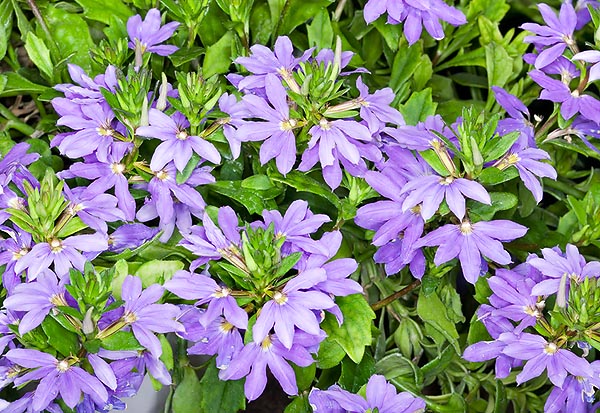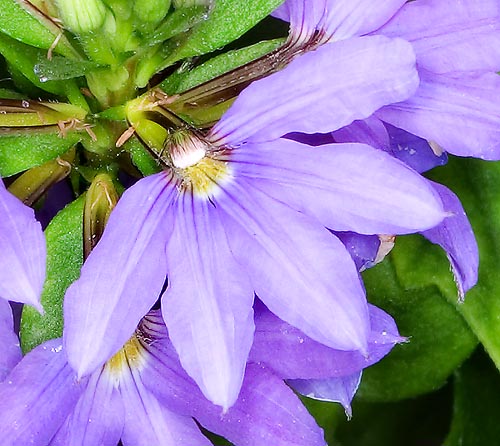Family : Goodeniaceae

Text © Pietro Puccio

English translation by Mario Beltramini

The Scaevola aemula is an Australian herbaceous plant fit for Mediterranean climates © Giuseppe Mazza
The name of the genus refers to the legendary Roman hero Mucius Scaevola (from the Latin scaevus, left-handed), who, in order to show his bravery to his enemy who had seized him, burnt his right hand into a brazier, with reference to the corolla which seems sliced in half; the name of the species comes from the Latin “aemulus” = emulator, imitator, with obvious reference.
Common names: common fan-flower, fairy fan-flower, half-flower (English); scaevola émule (French); flor-canhota (Portuguese); escaevola, escaévola, flor abanico (Spanish); Blaue Fächerblume (German).
The Scaevola aemula R. Br. (1810) is a much ramified evergreen herb, up to about 60 cm tall and about 1 m broad, with ascending or descending brownish stems, covered by sparse brownish yellow hairs. The leaves are alternate, sessile (without petiole), simple, thick, mostly of obovate shape, 2-10 cm long and 0,5-3 cm broad, with toothed edges, of an intense green colour.
The inflorescences are about 25 cm long spikes with bracts similar to the leaves, but smaller; the flowers are 1,5-2,5 cm long with a diameter of 2-3,5 cm with asymmetric, semicircular, corolla of a pale blue to intense purple blue colour with a usually yellow centre. There is also a more rare form with wholly white petals. The fruits are ovoid, indehiscent (which do not open spontaneously when ripe), capsules, pubescent, about 0,5 cm long, containing one or two ovoid seeds. It reproduces by seed and by semi-ripe cutting in sandy substratum at a temperature of about 20-22 °C. It is the most cultivated species of the genus due to the colour of the flowers, the abundant blooming, which lasts from mid spring to late autumn, and its easy cultivation.

The flower, similar to a hand, recalls the legendary hero Mucius Scaevola © G. Mazza
The soil must be well drained, acidic, rich of organic substance with addition of sand by around the 30% in order to improve its drainage. It resists to saltiness and therefore is particularly suitable for gardens located in the vicinity of the sea.
Watering in summer must be regular, but without excesses; pruning are to be done after the flowering in order to stimulate the production of new branches and to give the plant a more compact posture.
It may be treated as annual in the cold climates, seen its growing speed.
They have selected numerous varieties with different shades of colour and posture, erect, creeping, compact or drooping, these last ones are widely utilized for the cultivation in pot, even if hanging; when cultivated in pot, the substratum, with the aforementioned characteristics, must be kept almost always humid. The periodic fertilization are quite useful.
→ To appreciate the biodiversity within the GOODENIACEAE family please click here.
